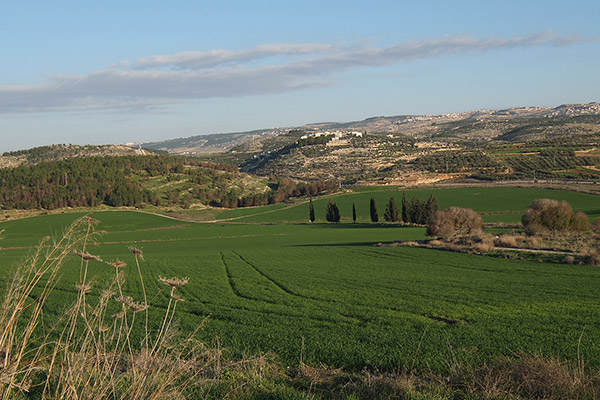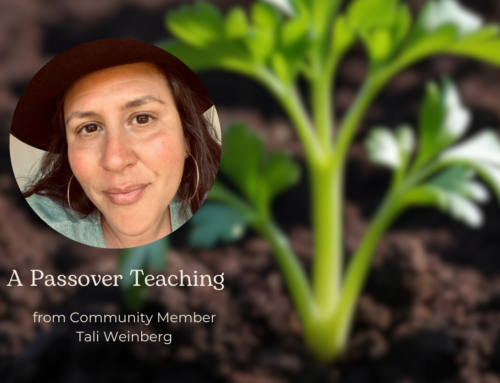Shmita: Shabbat for the Land
by Maggid Zelig Golden
22 Elul 5775 | September 17, 2014
Greetings from Jerusalem!
I have been here nearly two months and after an intense summer, I am grateful for the calm that has returned and the ability to synchronize with the rhythms of life and land. With each passing day, as the moon of the month of Elul wanes, the stinging heat of summer gives way to the cool fall air, and I hear the shofar blast echoing off of the cobble roads of Jerusalem.
The New Year is almost upon us and it’s time to wake up! This Rosh Hoshana is not just any new year, however. Just one week from now, we will light the Rosh Hoshana candles and sound the shofar to welcome the year 5775 and to begin the shmita year – the once-every-seven-year Shabbat for the Land. Around Jerusalem, shmita is the talk of the town.
Commonly translated from the Torah as the “Sabbatical Year,” shmita literally means “release.” The final year of a 7-year calendar cycle, shmita prescribes a cultural paradigm when we rest the land and forgive debts, shifting our cultural systems to foster an equitable, just, and healthy society. As Yigal Deutscher (founder of 7Seeds and Sukkot on the Farm 2014 keynote speaker) explains,
“Shmita is the focal point of Jewish earth-based traditions. More than a calendar year; shmita is primarily a way of being, a blueprint for a sacred, whole-systems culture, one grounded in vibrant, healthy and diverse relations between self, community, ecology, economy, and spirit.”
At the core, shmita calls us to rest the land: “In the seventh year, the land shall have a complete rest — a Sabbath to G!d.” (Leviticus 25:4). The Torah explains, “Six years you may sow your land and gather in its produce, but in the seventh year you shall release it and fallow it; the poor of your people shall eat from it, and what they leave over, the field animals shall eat.” (Exodus 23:10-11). Just as we have a day of rest once every seven days, the land, we are instructed, is to have a year of rest every seven years.
My friends all around Jerusalem are preparing to shift gears for the shmita. A whole host of rules and guidelines help us honor this Shabbat of the land. At the core is the prohibition from working the land or harvesting its produce as a commodity — during this year we do not plow, plant, prune, or cultivate. All we can do is allow the land to be just as it is, and to enjoy only the perennial fruits and wild edibles that grow on their own (called sefichin). These fruits, the rabbis teach, possess a heightened level of kedusha, or holiness, because they are taken with the intention of honoring the land during its year of rest. This kedusha sanctifies the harvest so that these foods must be eaten in their natural growing season, and never be wasted.
Furthermore, these harvests are not to be sold in the marketplace, as a commodity. The produce of the seventh year is said to be “ownerless” (hefker) and accessible to all.
As Rambam, the great medieval philosopher and commentator, explains:
“It is a commandment to divest one’s self from everything that the land produces in the seventh year, as Exodus 23:11 states: ‘In the seventh year, you shall leave it untended and unharvested.’ Anyone who locks his vineyard or fences off his agricultural field in the Sabbatical year has nullified a positive commandment.”
During this time, all who are hungry are permitted to walk into the fields and take what they need for this is also a time of taking down fences, sharing with neighbors, equalizing access to the bounty of the land, and opening to the faith that we will all have enough.
Intertwined with resting the land is the impulse to also create a more just society. During this year, the Torah also calls us to forgive debts:
“At the end of seven years, you are to make a release
[shmita]… he shall release every loan of his hand, forgiving what he has lent to his neighbor. He is not to oppress his neighbor or his brother, for the Release of G!d has been proclaimed.” (Lev. 15:1-2).
How shmita plays out here in Israel is fascinating. It’s important to note at the outset that the mitzvot (commandments) for shmita technically only apply to the land of Israel and to Jews living on that land. So, while I’ve delved into exciting conversations about shmita as the societal paradigm for sustainability and justice with potent universal values, here in Israel the conversations on the eve of shmita are also necessarily focusing on thetachlis, or details, with questions like:
- “Can I harvest tomatoes that were planted prior to Rosh Hoshana?”
- “What vegetables are permissible to buy in the shuk (market)?”
- “Can I buy vegetables grown by non-Jews living in the land of Israel?”
- “What about vegetables grown in a green house or raised beds?”
- “Do shmita rules apply to herbs grown in pots in the kitchen?”
The answer to this last question is “no” because potted plants are not rooted in the land itself. Because we Jews have lived mostly unrooted from this land until only a couple of generations ago, the rules and customs that governshmita are a work in progress. So, like the rabbis of the Talmud, there is disagreement about many questions and the rabbis are actively debating and guiding Israeli society on how to navigate modern farming, markets, and a food system.
At least some of the rules are clear. For example, it is plain that shmita fruits and vegetables cannot be sold in the marketplace as usual. So, communities are organizing direct relationships with farms and farmers to receive shmitafood direct from the land. Here in my Jerusalem neighborhood Nachlaot, I will be joining a special shmita food co-op that will observe the letter and spirit of shmita – to learn more about the shmita rules and how this co-op works, check out the Nachlaot Shemitta Co-op website.
Whether we live in Israel or not, shmita provides a powerful paradigm for our people. In this time of ecological uncertainty and global injustice, Jews across the world are stepping toward the task of embracing shmita and the profound values it professes. Our friends and partners at Hazon have created an incredible set of resources that explore the Biblical sources and lineage of thought about shmita. I highly encourage you to explore these invaluable resources at the Shmita Project.
Our very own Yigal Deutscher, one of the driving forces behind the ShmitaProject, has become one of the foremost voices on shmita as a Jewish paradigm for healing the broken threads between individuals, communities, land and the sacred. Yigal’s 7Seeds Project articulates the use of shmitaconsciousness to weave the principles of permaculture, indigenous consciousness, and transition town activism into a holistic system based on ancient Jewish values. As he explains:
“These are potent times of transition, from perceived scarcity to revealed abundance, from the age of the individual to the age of the communal…. In this momentum of growth, there is a stirring and rising of the ancient memories planted deep inside us from the wisdom and tales of our early ancestors. In this timeless story, there is a code which lays out the vision for a sacred community that is grounded in abundance, equality, generosity, love, and the ability to have trust in the unknown. This code is held within theshmita cycle.”
Yigal explains that shmita is not only about the seventh year. Rather it indicates how we might conduct ourselves during the six years preceding because shmita is a holistic cycle rather than an isolated moment in time. What would it be like if in the sixth year we really could rely on our agricultural systems to feed us with no planting, weeding, and pruning? What would our farms look like? How can the modern art of permaculture support this ancient way? What if we really could live in a gift economy and release our debts in the seventh year? What would it take during the six years preceding shmita to make such a world possible? I encourage you to explore Yigal’s “Shmita Manifesto,” a beautiful articulation of the potential of shmitafor our time and for what I think provides the most potent answers to these questions.
The values of shmita directly relate to the core teachings of Wilderness Torah. Each Passover, for example, we gather in the desert and spend solo time with ourselves in the wilderness. Before we go, we ask the question found in the midrash: “Why was the Torah given in the wilderness of Sinai?” The midrash teaches that unless the people make themselves hefker(“ownerless”) like the wilderness [and yes, just like the food during shmita], they would not be able to attain the wisdom of the Torah.” (Bamidbar Rabbah 1:7). So too, making our food and property hefker like the wilderness provides a powerful key to our personal evolution and the transformation of our fundamental relationships.
As Yigal explains in the “Shmita Manifesto”:
“To leave land fallow is not simply to pause, or to create a static snapshot in time. It is to allow for a period of transformation and renewal. When we step aside, the land responds, and she does so by expressing her untamed, wild self, recalling a period beyond domestication, beyond civilization…shmita offers us a delicate edge where our two identities, our civilized and wild reflections, can meet and merge together, in union and love.”
In just one week, we welcome shmita. The door is wide open to embrace the ancient wisdom from the Torah and the rabbis. Join us for Sukkot on the Farm as we celebrate the harvest from the previous year and explore shmitaas our central theme, looking toward a different type of harvest in the coming year. Here in Israel, I’ll begin shmita by considering even more deeply where my food comes from and how I can sink into a more natural rhythm. For six days we work and the seventh we rest — so too in this seventh year I want to set the intention that I begin learning how to embrace and embodyshmita. What intention might you set for this shmita year?
With warm regards from Jerusalem, I leave you with the words of Rav Kook, the first Chief Rabbi of Israel (from his seminal work, Shabbat Ha’Aretz(“Sabbath of the Land”)):
“What the Sabbath achieves regarding the individual, the shmitaachieves with regard to the nation as a whole. A year of solemn rest is essential for both the nation and the land, a year of peace and quiet without oppressor and tyrant…it is a year of equality and rest, in which the soul reaches out towards divine justice, towards G!d who sustains the living creatures with loving kindness.”
Shana Tova u’Metuka — A Happy and Sweet New Year!





